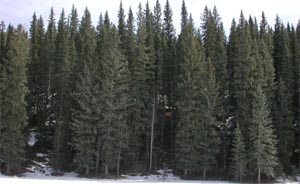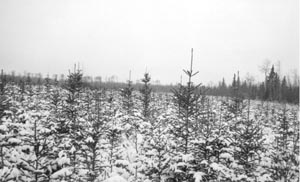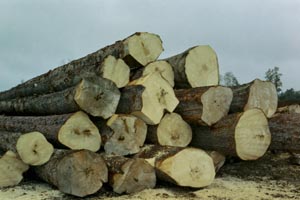| | White spruce are commonly found in Alberta as part of a mixed forest of aspen, white spruce, birch and balsam poplar. Pure white spruce stands are rarely found in woodlots. The wood is valuable, it is important for landowners know how to manage a white spruce forest.
White spruce is one of the most valued wood species in Canada. The wood is light in color, straight-grained and resilient. It’s low in weight when dried and has very good machining properties. White spruce timber is used for building lumber, plywood and pulpwood. The low resin content and long fibers make it excellent for pulp, paper and newsprint manufacturing. White spruce wood is also used for house logs, musical instruments, paddles, cabinets, canoes, boxes and containers.
White spruce stands provide shelter, cover and food for many wildlife species. Moose, white-tailed deer and elk use white spruce stands for thermal protection. Many seed eating birds such as spruce grouse, chickadees, nuthatches, crossbills, and pine siskins extract seeds from open spruce cones and eat seeds off the ground. Squirrels, shrews, mice, and voles all live in white spruce forests and consume various parts of the tree. Marten, wolverine, lynx, wolves and other prey species also utilize these forests. White spruce forests maintain soil stability and watershed values and are used for recreation.
Growing conditions
White spruce grows best in well-drained, moist, silty loam and clay soils. It can also grow on many different soil types and can withstand some flooding during the growing season. It grows poorly on sandy soils or sites with a high water table and does not tolerate saline soils. Young seedlings will handle acid soils up to pH 4.5.
In shallow soils white spruce roots grow fairly flat and close to the soil surface while in deeper soils it forms a “heart” like root system. White spruce is very susceptible to being blown over when grown on thin or wet soils because of its shallow root system. Areas of blown down spruce are prime breeding sites for the spruce beetle, a devastating insect that can easily spread to mature trees and kill them. Fallen trees also increase the risk of fire on your property.

Even aged white spruce stand
White spruce grows best in full sunlight and it tolerates shade. In a mixed aspen and white spruce forest, young white spruce can grow under the protection of the aspen canopy until they reach the lowest aspen branches. At that time, the aspen should be removed to allow the white spruce to grow faster. In mixed wood coniferous stands, white spruce will often become the dominant tree species as the stand ages.
Regeneration
White spruce produce thousands of seeds every four years but do not follow a regular cycle. In natural stands, cone production occurs primarily on dominant and co-dominant trees. Seeds remain viable for only 1 or 2 years. Under natural conditions, seeds overwinter under the snow and germinate in the spring when there is adequate soil moisture and warmth.
Seedling establishment is most successful on mineral soils and rarely occurs on deep organic layers. Seedlings are frequently found on rotten wood. Seedlings grow best in full sunlight, they can tolerate low light and shade.
A clear-cut patch should be no smaller than 0.5 hectares (2 acres) in size. This is large enough to allow direct sunlight to warm the soil and stimulate seed germination and seedling growth. In a larger clear-cut site scattered residual trees have to be left to provide seed as successful natural regeneration requires a nearby seed source. Seed trees should be uniformly distributed to ensure an adequate seed supply to harvested areas.

Natural regeneration of white spruce after harvesting
Photo by: Con Dermott -Vanderwell Contractors (1971) Ltd
If natural regeneration does not occur tree planting is necessary. Planting rates vary from 1200 to 2200 white spruce trees per hectare. Site preparation is also necessary for successful tree planting regeneration.
Harvesting
Several harvesting methods can be used in white spruce stands including clear-cut, shelterwood cut or selection cut. Clear-cutting removes all the trees at once from an area not less than 0.5 hectares. Shelterwood cutting removes trees in two or tree stages. Both of these methods are used for white spruce forests where the trees are the same age. If you have white spruce trees of differing ages in your woodlot, use selective harvesting. Selective harvesting removes old, deformed, overly mature and unhealthy trees while keeping the young and healthy ones.
White spruce matures between 80 and 120 years of age. Trees should be harvested at maturity. In an overstocked area some thinning may be necessary to improve growth. Pruning is necessary to produce log house timber. White spruce should be harvested in the winter to minimize the risk of rutting, compaction and puddling from forest equipment.

White spruce logs
Management recommendations for landowners with white spruce include:
- Encourage natural regeneration when harvesting, before harvest look for seed cones at the top of the trees. If there are no seed cones wait until a 'seed' year to harvest.
- Tree plant if natural regeneration has not happened in first two years.
- Reduce the impact of livestock grazing in the white spruce stand. Livestock trampling can injure tree root systems.
- Leave old, branchy, stable trees as seed sources.
- Prevent blow downs by protecting white spruce stands from prevailing winds.
- Protect the woodlot from uncontrolled fire.
- Juvenile thinning might be necessary if the area is overstocked.
- Winter harvesting as it reduces the risk of compaction and root damage.
- Irregularly shaped cut blocks.
- Leaving snag and dead trees after harvesting for wildlife habitat.
- Diversify the age structure of the woodlot through small patch harvesting.
|
|